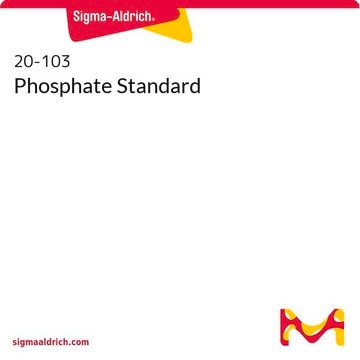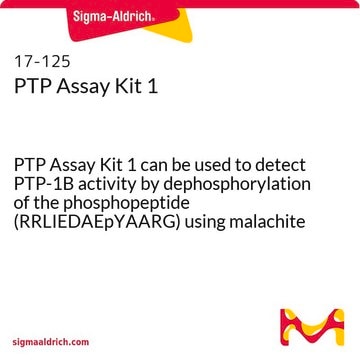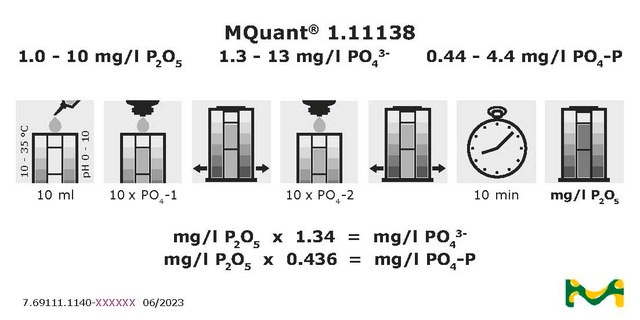There is no guarantee that this assay will detect phosphate covalently bound to a protein. It is possible that the acidic conditions of the working reagent will free the bound phosphate and detect it, but this has not been tested. This assay has a lower limit of detection of 0.4 uM free phosphate.
Wichtige Dokumente
MAK308
Phosphat-Assay-Kit
sufficient for 500 colorimetric tests
Größe auswählen
About This Item
Empfohlene Produkte
Verwendung
sufficient for 500 colorimetric tests
Nachweisverfahren
colorimetric
Relevante Krankheit(en)
gastrointestinal diseases; cardiovascular diseases
Lagertemp.
2-8°C
Verwandte Kategorien
Allgemeine Beschreibung
Anwendung
- Phosphatase-Assays: Freisetzung von Phosphat aus Peptid-, Protein- oder Kleinmolekülsubstrat.
- Lipase-Assays: Freisetzung von Phosphat aus Phospholipiden
- Nukleosid-Triphosphatse-Assays: Freisetzung von Phosphat aus Nukleosid-Triphosphaten (ATP, GTP, TTP, CTP etc).
- Quantifizierung des Phosphats in Phospholipiden, Proteinen und DNA etc.
- Arzneimittelforschung: Hochdurchsatz-Screening auf Phosphatasehemmer.
Leistungsmerkmale und Vorteile
- Hohe Sensitivität und breiter Erfassungsbereich: Nachweis von so geringen Mengen wie 20 pmol Phosphat und ein nutzbarer Bereich von 0,4–50 µmol/l Phosphat.
- Schnell und praktisch: Der homogene “Mix-and-measure”-Assay ermöglicht die Quantifizierung von freiem Phosphat in 30 Minuten.
- Mit gängigen Labor- und HTS-Formaten kompatibel: Die Assays können in Röhrchen, Küvetten oder Mikrotiterplatten auf Spektrophotometern und Plattenlesern durchgeführt werden.
- Robust und für HTS geeignet: Z-Faktoren von 0,7–0,9 werden in 96-Well-Platten beobachtet. Lässt sich leicht für eine automatisierte Handhabung von Flüssigkeiten auf HTS-Systemen automatisieren.
Eignung
Prinzip
Signalwort
Warning
H-Sätze
P-Sätze
Gefahreneinstufungen
Met. Corr. 1
Lagerklassenschlüssel
8B - Non-combustible corrosive hazardous materials
WGK
WGK 1
Flammpunkt (°F)
Not applicable
Flammpunkt (°C)
Not applicable
Hier finden Sie alle aktuellen Versionen:
Analysenzertifikate (COA)
Die passende Version wird nicht angezeigt?
Wenn Sie eine bestimmte Version benötigen, können Sie anhand der Lot- oder Chargennummer nach einem spezifischen Zertifikat suchen.
Besitzen Sie dieses Produkt bereits?
In der Dokumentenbibliothek finden Sie die Dokumentation zu den Produkten, die Sie kürzlich erworben haben.
Kunden haben sich ebenfalls angesehen
-
Can this assay be used to measure phosphate from Tyrosine phosphorylated proteins? I have SH2 domain proteins, which binds to pY-proteins. I want to measure the amount of phosphate in each SH2 sample before phosphopeptide enrichment and MS-analysis
1 answer-
Helpful?
-
-
How is shipping temperature determined? And how is it related to the product storage temperature?
1 answer-
Products may be shipped at a different temperature than the recommended long-term storage temperature. If the product quality is sensitive to short-term exposure to conditions other than the recommended long-term storage, it will be shipped on wet or dry-ice. If the product quality is NOT affected by short-term exposure to conditions other than the recommended long-term storage, it will be shipped at ambient temperature. As shipping routes are configured for minimum transit times, shipping at ambient temperature helps control shipping costs for our customers. For more information, please refer to the Storage and Transport Conditions document: https://www.sigmaaldrich.com/deepweb/assets/sigmaaldrich/marketing/global/documents/316/622/storage-transport-conditions-mk.pdf
Helpful?
-
-
How can I determine the shelf life / expiration / retest date of this product?
1 answer-
If this product has an expiration or retest date, it will be shown on the Certificate of Analysis (COA, CofA). If there is no retest or expiration date listed on the product's COA, we do not have suitable stability data to determine a shelf life. For these products, the only date on the COA will be the release date; a retest, expiration, or use-by-date will not be displayed.
For all products, we recommend handling per defined conditions as printed in our product literature and website product descriptions. We recommend that products should be routinely inspected by customers to ensure they perform as expected.
For products without retest or expiration dates, our standard warranty of 1 year from the date of shipment is applicable.
For more information, please refer to the Product Dating Information document: https://www.sigmaaldrich.com/deepweb/assets/sigmaaldrich/marketing/global/documents/449/386/product-dating-information-mk.pdfHelpful?
-
-
What is the recommended method for preparing tissue and cell samples for use with the MAK308-1KT Phosphate Assay Kit? Should detergent or another solution be used for these samples?
1 answer-
Utilizing mechanical lysis over detergent-mediated lysis whenever feasible. This is particularly crucial in this instance as detergents could lead to undesired phosphate contamination. They suggest employing a Dounce Homogenizer or sonication. Additionally, the extent of tissue and/or cell lysis can be visually verified using a microscope, if accessible.
Helpful?
-
Active Filters
Unser Team von Wissenschaftlern verfügt über Erfahrung in allen Forschungsbereichen einschließlich Life Science, Materialwissenschaften, chemischer Synthese, Chromatographie, Analytik und vielen mehr..
Setzen Sie sich mit dem technischen Dienst in Verbindung.









